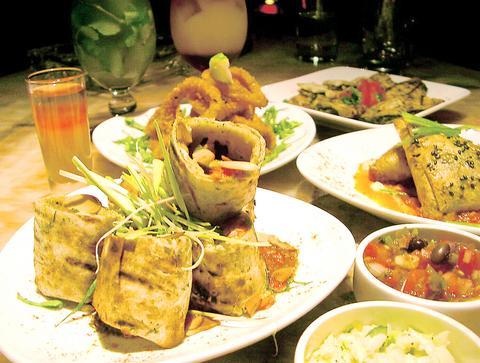If you're not a fan of Latin music or a good salsa dancer, there are still plenty of reasons to visit Barrio, the new Latin bar in Taipei: the food for example. At Barrio there are no microwave pizzas or cold snacks, and no burritos or enchiladas, the flour for which comes from Taipei's Florida bakery.
Barrio's kitchen offers a third choice, what chef Tomer Feldman calls "fusion Latino food." On the menu you see interesting combinations such as Latino sushi or Italian-styled quesadillas.
"I wanted people to see the unexpected when they come here, and to have some new impressions about Latin food," said Israeli-born Feldman. Having been a chef at up-scale New York restaurants for 12 years, such as Italian restaurant Puccini in upper West and Bari Cafe in Soho, Feldman said he's experienced with Latin food. Creating variations and fusion seems to interest him most. In Taiwan, his previous job was a chef at Rendezvous, the first fusion Italian restaurant in Taipei.

PHOTO: YU SEN-LUN, TAIPEI TIMES
Latino sushi is actually tortilla rolls, like burritos, but chopped in slices which resemble sushi. Goat cheese and roasted pepper roll is the best-selling item so far among the Latino sushi dishes. Traditionally, Mexican burritos comprise wrapped rice and beans, thus giving a heavy feel after a meal. In Feldman's recipes the fillings are much lighter and healthier, good for dancing, perhaps?
One more reason to eat at Barrio is you get to taste different kinds of dipping sauces with just one tapas dish. According to Feldman having different dipping sauces in one dish is common to Israeli restaurants. These home-made sauces have, again, each been infused with unusual ingredients. Salsa sauces are added to beans and toasted with ground cumin seeds. Coleslaw is added to jalapenos for a spicy coleslaw, or "fusion kimchi."
In March, Barrio's kitchen will present main course dishes such as burritos, enchiladas and tacos. "But again, they will be unconventional Latin main courses," Feldman said.

Seven hundred job applications. One interview. Marco Mascaro arrived in Taiwan last year with a PhD in engineering physics and years of experience at a European research center. He thought his Gold Card would guarantee him a foothold in Taiwan’s job market. “It’s marketed as if Taiwan really needs you,” the 33-year-old Italian says. “The reality is that companies here don’t really need us.” The Employment Gold Card was designed to fix Taiwan’s labor shortage by offering foreign professionals a combined resident visa and open work permit valid for three years. But for many, like Mascaro, the welcome mat ends at the door. A

If China attacks, will Taiwanese be willing to fight? Analysts of certain types obsess over questions like this, especially military analysts and those with an ax to grind as to whether Taiwan is worth defending, or should be cut loose to appease Beijing. Fellow columnist Michael Turton in “Notes from Central Taiwan: Willing to fight for the homeland” (Nov. 6, page 12) provides a superb analysis of this topic, how it is used and manipulated to political ends and what the underlying data shows. The problem is that most analysis is centered around polling data, which as Turton observes, “many of these

Since Cheng Li-wun (鄭麗文) was elected Chinese Nationalist Party (KMT) chair on Oct. 18, she has become a polarizing figure. Her supporters see her as a firebrand critic of the ruling Democratic Progressive Party (DPP), while others, including some in her own party, have charged that she is Chinese President Xi Jinping’s (習近平) preferred candidate and that her election was possibly supported by the Chinese Communist Party’s (CPP) unit for political warfare and international influence, the “united front.” Indeed, Xi quickly congratulated Cheng upon her election. The 55-year-old former lawmaker and ex-talk show host, who was sworn in on Nov.

Even the most casual followers of Taiwan politics are familiar with the terms pan-blue and pan-green. The terms are used so casually and commonly with the assumption that everyone knows what they mean, that few stop to really question it. The way these terms are used today is far broader and extensive than what they were originally created to represent. Are these still useful shorthand terms, or have people become so obsessed with them that they color perceptions to the point of distortion? LEE TUNG-HUI WAS NO SMURF People often assume that these terms have been around forever, or at least as